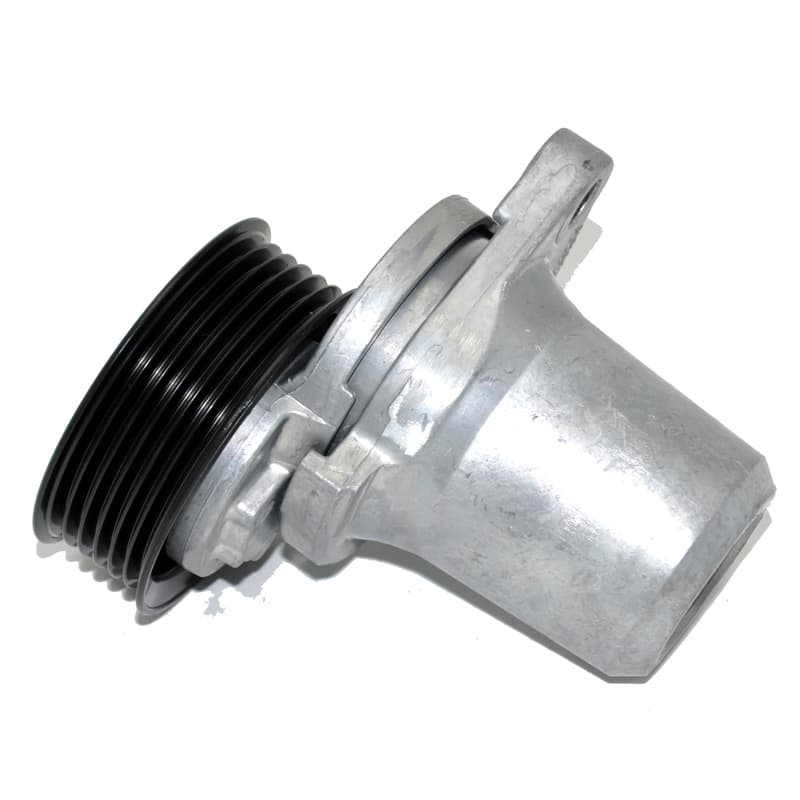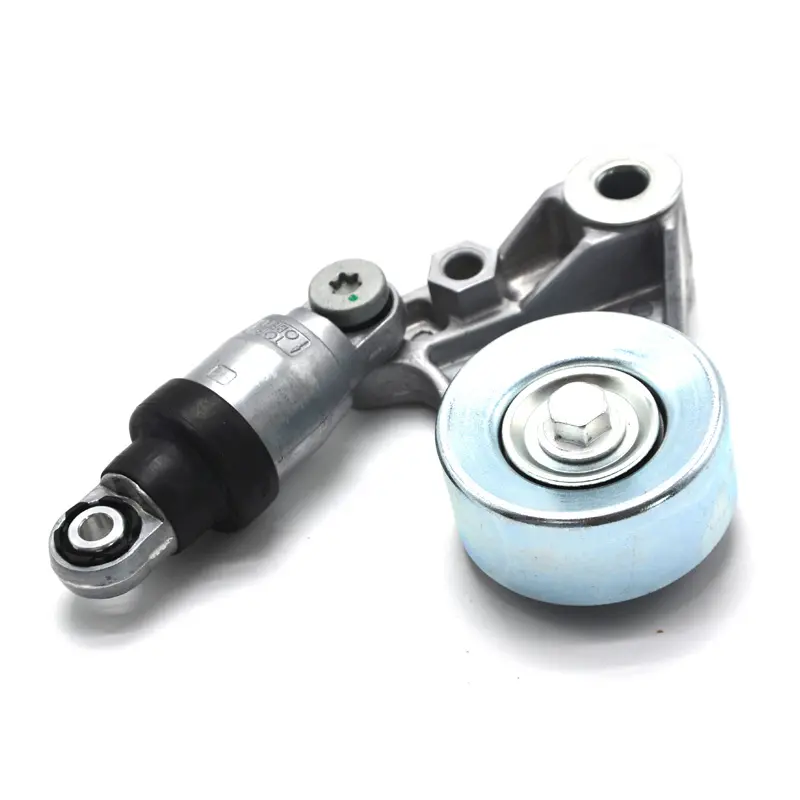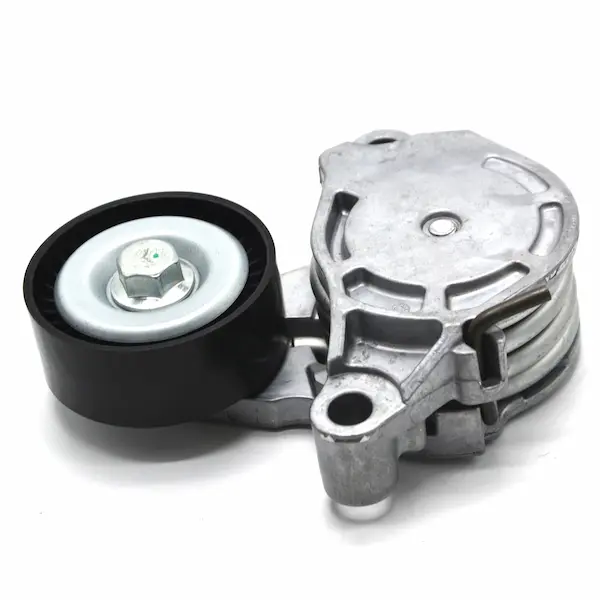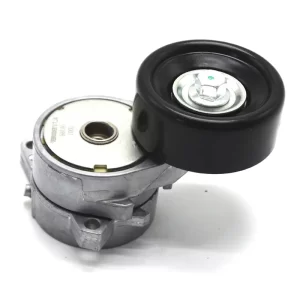Inzicht in span- en geleiderpoelies: Essentiële onderdelen voor optimale motorprestaties
Span- en geleiderollen spelen een onmisbare rol in het effectieve beheer van zowel distributieriemen als extra aandrijfriemen in auto's en industriële motoren. Deze componenten zijn essentieel om een soepele werking van de motor te garanderen en de levensduur van de riemaangedreven systemen te verlengen.
Spanrollen
De spanrol is cruciaal voor het handhaven van de juiste spanning in de aandrijfriem, wat fundamenteel is voor een efficiënte vermogensoverdracht en het voorkomen van problemen zoals het slippen van de riem of vroegtijdige slijtage. Dit onderdeel maakt gebruik van een veerbelast of hydraulisch systeem om de spanning automatisch aan te passen wanneer de riem uitrekt of inkrimpt als gevolg van operationele spanningen. Door zich voortdurend aan te passen aan de veranderingen, helpt de spanrol om consistente prestaties te behouden en verlengt hij de levensduur van de riem en de bijbehorende onderdelen.
Idler Katrollen
Leiderpoelies daarentegen passen de spanning niet actief aan, maar dienen om de riem rond verschillende motoronderdelen te geleiden, zoals alternators, waterpompen en aircocompressors. Hun belangrijkste rol is het handhaven van de juiste uitlijning van de riem, wat trillingen minimaliseert en slijtage vermindert. Door ervoor te zorgen dat de riem goed uitgelijnd blijft, helpen spanrollen de spanning gelijkmatig over de riem te verdelen, wat bijdraagt aan de soepele werking van de motor en problemen met betrekking tot verkeerde uitlijning voorkomt.
Beide soorten poelies zijn ontworpen om de veeleisende omstandigheden van motoromgevingen te weerstaan. Ze zijn gebouwd om hoge temperaturen, voortdurende trillingen en meedogenloze rotatiekrachten te weerstaan. De duurzaamheid en betrouwbaarheid van deze componenten zijn cruciaal voor het behoud van de prestaties en de levensduur van de riemaangedreven systemen van de motor, wat hun belang in de moderne mechanische en automobieltechniek onderstreept.
Idler katrollen installeren: Een uitgebreide stap-voor-stap handleiding
1. Voorbereiding:
- Montage gereedschap: Verzamel essentieel gereedschap zoals sleutels, doppen, een momentsleutel en eventueel een poelietrekker. Als je het juiste gereedschap bij de hand hebt, verloopt het installatieproces soepeler.
- Handmatig overleg: Raadpleeg de onderhoudshandleiding van uw voertuig voor gedetailleerde installatie-instructies, inclusief schema's en koppelspecificaties. Dit garandeert nauwkeurigheid en helpt mogelijke problemen tijdens de installatie te voorkomen.
2. Veiligheidsmaatregelen:
- Batterij loskoppelen: Om te voorkomen dat de motor per ongeluk wordt gestart, moet de minpool van de accu worden losgekoppeld. Deze stap is cruciaal voor uw veiligheid tijdens het installatieproces.
- Motorkoeling: Laat de motor volledig afkoelen voordat u met het werk begint. Dit voorkomt brandwonden door hete onderdelen en zorgt voor een veiligere werkomgeving.
3. Riem verwijderen:
- Riemspanning loslaten: Gebruik een sleutel of een spanner om de spanning van de serpentijn- of distributieriem te halen. Let op de positie van de spanner en de kracht die nodig is om de riem op de juiste manier te verwijderen.
- De riem verwijderen: Schuif de riem voorzichtig van de geleiderpoelie en andere poelies. Let op de geleiding van de riem om deze later nauwkeurig te kunnen herinstalleren.
4. De oude rondselpoelie verwijderen:
- Bevestigingen zoeken en verwijderen: Identificeer en verwijder de bouten of bevestigingsmiddelen waarmee de oude spanrol vastzat. Bewaar deze bevestigingen omdat ze nodig zijn voor de nieuwe installatie.
- De poelie verwijderen: Als de oude poelie weerstand biedt, gebruik dan een poelietrekker om deze voorzichtig te verwijderen. Gebruik niet te veel kracht om schade aan aangrenzende onderdelen te voorkomen.
5. Onderdelen inspecteren:
- Riem en riemschijven onderzoeken: Controleer de riem op tekenen van slijtage, zoals scheuren of verglazing. Controleer andere poelies op beschadigingen of overmatige slijtage en vervang onderdelen die in slechte staat verkeren.
- De omgeving schoonmaken: Reinig het montagegedeelte grondig om vuil en oude smeermiddelen te verwijderen. Een schoon oppervlak zorgt voor een stevige installatie van de nieuwe poelie.
6. De nieuwe vrijlooppoelie installeren:
- De katrol plaatsen: Lijn de nieuwe spanrol uit met het montagepunt en zorg ervoor dat deze overeenkomt met de oriëntatie van de oude spanrol. De juiste uitlijning is essentieel voor een correcte installatie.
- Vastzetten met bouten: Plaats de bevestigingsbouten of -bevestigingen en draai ze vast. Gebruik een momentsleutel om het juiste aanhaalmoment toe te passen volgens de specificaties van de fabrikant. Draai de bouten niet te strak aan, want dat kan de poelie of het montagegedeelte beschadigen.
7. De riem terugplaatsen:
- Volg het routediagram: Zorg ervoor dat de riem correct wordt geplaatst over alle poelies, inclusief de nieuwe spanrol, volgens het schema. Nauwkeurig geleiden voorkomt verkeerde uitlijning en zorgt voor een goede werking van de riem.
- Pas de juiste spanning toe: Stel de riemspanning af met het spangereedschap. Controleer bij automatische spanners of ze goed werken om de juiste spanning te handhaven.
8. Uitlijningscontrole:
- Controleer gordelzitting: Controleer of de riem goed in alle groeven van de poelie zit. Een goede plaatsing is cruciaal om slippen te voorkomen en een soepele werking te garanderen.
- Zorgen voor soepele rotatie: Controleer of de spanrol soepel draait zonder wiebelen of weerstand. Dit wijst op een correcte installatie en uitlijning.
9. Operationeel testen:
- Sluit de batterij weer aan: Sluit de negatieve accupool weer aan zodra de installatie is voltooid.
- Motor starten: Start de motor en controleer de werking van de riem en de spanrol. Luister naar ongewone geluiden zoals piepen of ratelen, wat kan duiden op problemen met de installatie of uitlijning.
- Riemtracering controleren: Zorg ervoor dat de riem correct over alle poelies loopt zonder te slippen of te ontsporen. Een goede geleiding is essentieel voor het effectief functioneren van het riemaandrijfsysteem.
Door deze gedetailleerde stappen te volgen, kun je een nauwkeurige en veilige installatie van de spanrol bereiken, waardoor je verzekerd bent van optimale prestaties en een langere levensduur van de riemaandrijving van je auto. Een juiste installatie verbetert niet alleen de functionaliteit van je motor, maar draagt ook bij aan de algehele betrouwbaarheid en efficiëntie van je voertuig.







